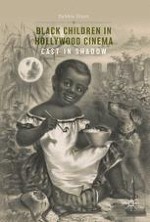
2017 | OriginalPaper | Buchkapitel
1. Introduction
verfasst von : Debbie Olson
Erschienen in: Black Children in Hollywood Cinema
Aktivieren Sie unsere intelligente Suche, um passende Fachinhalte oder Patente zu finden.
Wählen Sie Textabschnitte aus um mit Künstlicher Intelligenz passenden Patente zu finden. powered by
Markieren Sie Textabschnitte, um KI-gestützt weitere passende Inhalte zu finden. powered by
Abstract
One common thread running through these remarks is the surprise that a black girl would play an “innocent child,” despite the fact that the author’s description in the novel specifically described Rue as having “dark brown skin.” Maria Tatar in “Little, Blonde, Innocent, and Dead,” observes that the criticism of the film by fans was not directed at the “sacred prohibition against the onscreen killing of children” that comprises the film’s plot, but rather was because those children themselves violated the expected ethnicity of the sympathetic character or the hero. Tatar observes how, culturally, it is the deaths of blonde girls that most often capture media attention; there is rarely a national media blitz for missing young black girls (or boys, for that matter).4 Tatar suggests that such attitudes about who is innocent and who is not, who should be the hero or the savior, can be traced back to the literary depictions of two young girls: Little Eva, the golden-haired, angelic child, and Topsy, the orphaned and abused slave child, from Harriet Beecher Stowe’s 1852 novel Uncle Tom’s Cabin, standard reading in most American literature survey classes. As Tatar describes:“why does Rue have to be black not gonna lie kinda ruined the movie” (Maggie Mcdonnell, @maggie_mcd11)“cinna and rue werent supposed to be black/why did the producer make all the good characters black smh” (Mari)“EWW rue is black?? I’m not watching” (Joe Longley, @joe_longley)“Kk call me racist but when I found out rue was black her death wasn’t as sad” (#ihatemyself, Jashper Paras, @jashperparas)“nah, I just pictured darker skin, didn’t’ really take it all the way to black” (Jordan Wright, @JBanks56)“rue is black?!?! Whaa?!” (@MAD_1113)“Awkward moment when Rue is some black girl and not the little blonde innocent girl you picture” (Alana, @sw4q)3
Tatar quotes Stowe’s juxtaposition of the two children only in part; the rest of that passage from Stowe continues: “There stood the representatives of their races. The Saxon, born of ages of cultivation, command, education, physical and moral eminence; the Afric, born of ages of oppression, submission, ignorance, toil, and vice!”6 Though these descriptions of the two races are over 100 years old, they are still repeated daily in the ways that visual media articulate, to use Stuart Hall’s notion, children from the Global North and the Global South.In a spacious bedroom decorated with white muslin curtains, an alabaster desk, and marble vases, the dying Little Eva, pale and pious, distributes locks of her golden-brown hair along with nuggets of Christian wisdom. Her blondeness is linked with beauty and fairness, in all its semantic nuances … ‘There stood the two children, representatives of the two extremes of society. The fair high-bred child, with her golden head, her deep eyes, her spiritual, noble brow, and prince-like movements; and her black, keen, subtle, cringing, yet acute neighbor’ … Stowe was most likely seeking to extend the protective energies generated by beauty to an innocent victim of social injustice, and indeed Topsy, against all odds, survives, and has the chance to be ‘an angel forever.’ ‘Just as much as if you were white,’ Eva reassures her, using a phrase that makes alarm bells go off in our heads.5